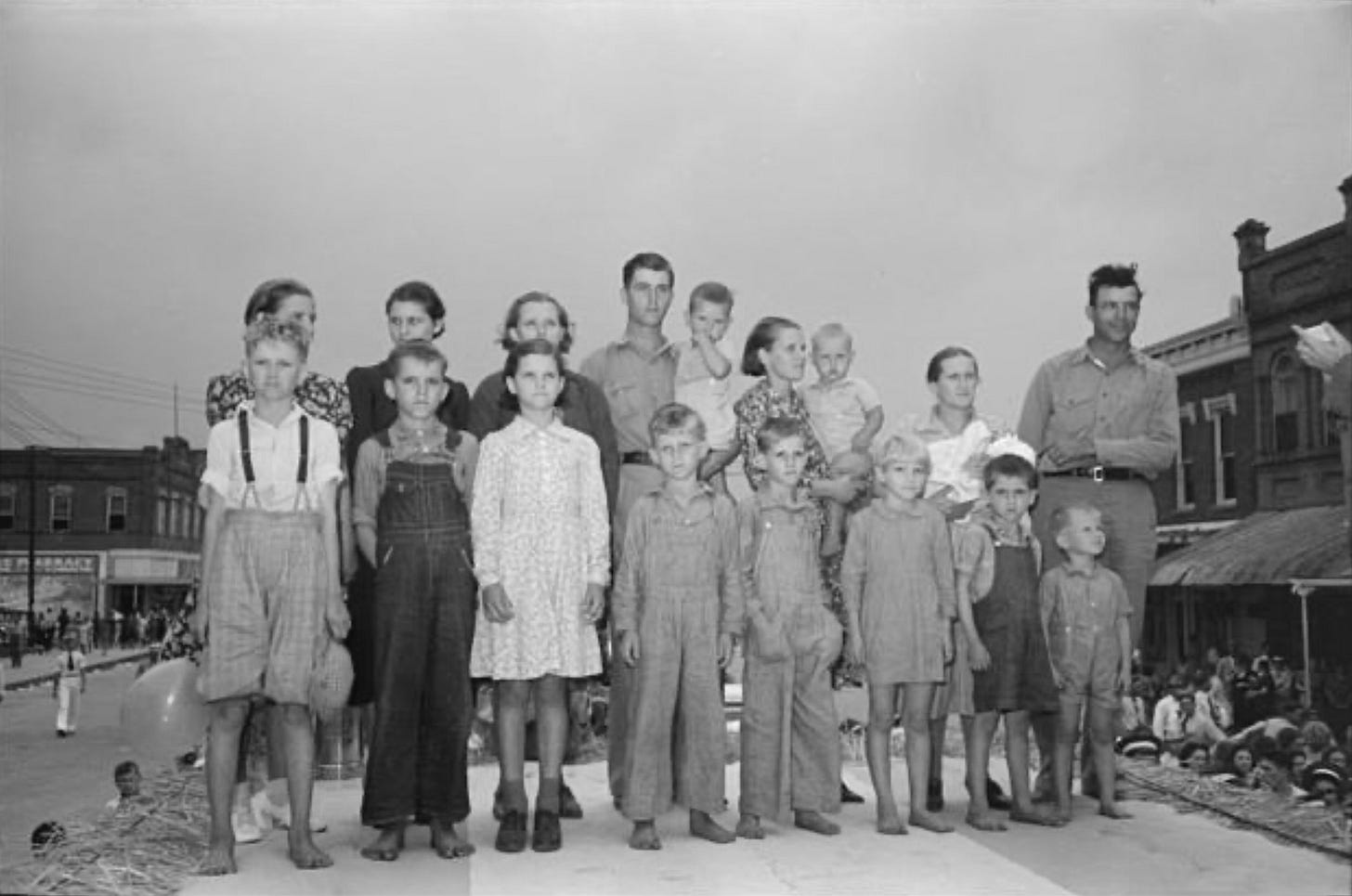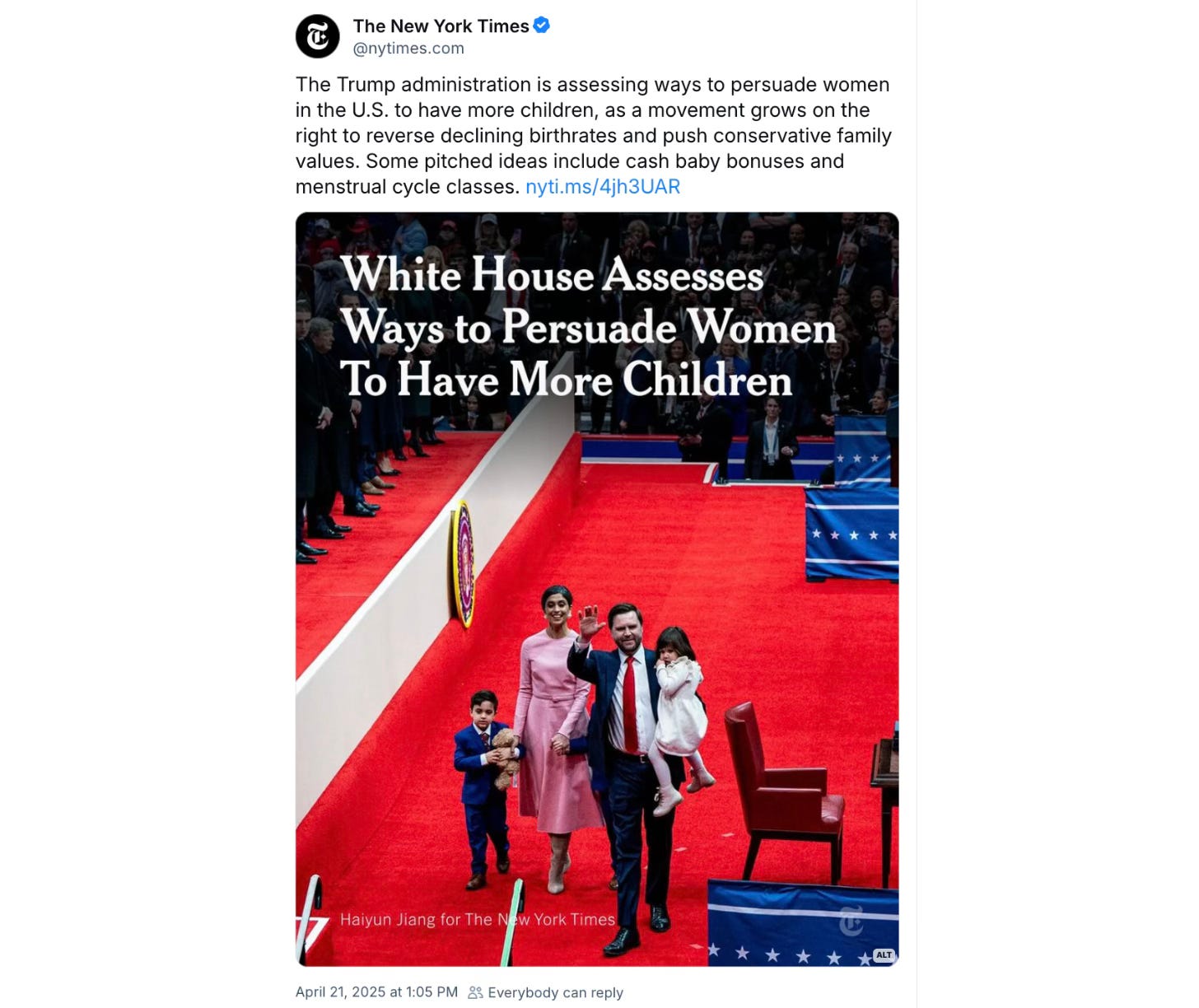Margaret Sanger Would’ve Set the ‘More Babies’ Movement on Fire
Expecting a baby a year from wedding to menopause is no way to care for women, children, or families. Don't let billionaires & tech bros take away this right generations have depended upon.

The mother of contraception is news again
Margaret Sanger’s name has become a lightning rod. Conservative Christian groups like The 1916 Project accuse her of:
promoting eugenics — she didn’t.
racism — also didn’t.
single-handedly triggering the sexual revolution — her work was mainly with married women, so…nope.
decline of the traditional family — she had three kids and was devoted to her husband, so nope again.
She's blamed for broad cultural shifts that happened sixty and seventy years after she began her work in the early 1900s. What she is responsible for — and proudly so — is the availability of safe and effective birth control. When she’s accused of helping women around the world take control of how many children they conceive, we can say yes, absolutely! Birth control for women of every economic class was the driving force behind her work.
Yet now, those who would take away what Sanger fought to provide — safe and effective birth control — have emerged from culture’s dark recesses to the halls of government.
At a $10K-per-person Natal Conference, far-right influencers host matchmaking sessions aiming to 'repopulate the Earth'—complete with on-site ministers ready to officiate marriages.
It seems a lot of men are pushing women back into the lifestyles of their great-grandmothers, which can momentarily sound terribly romantic, but what’s the real cost?
What was life like before Sanger’s advocacy for contraception? And what are the real consequences of today's “make more babies” crusade, now echoed by billionaires and fundamentalists alike?
Life before birth control: yearly pregnancy and gravestones
In New England, where I live, we have plenty of old cemeteries. A walk through any one of them will show the grim results of the centuries before reproductive education and reliable birth control. The casual visitor will see many graves of husbands, who lived well into their dotage. Beside them will be two, three, and sometimes four graves of their wives, buried often along with their infant children.
There were plenty of men like Nicholas C. Strohl, a farmer from the Lehigh Valley area of Pennsylvania, who fathered 33 children through three wives. Most didn’t have that a house quite that full, but the pattern of remarry-and-repeat as the wives passed silently away was prevalent.
Let’s remember that in those days, the second, third, or fourth marriage didn’t follow divorce, but a death—and those deaths often were related to childbirth.
“No woman can call herself free who does not own and control her own body.”
— Margaret Sanger, Woman and the New Race (1920)
And if the mother didn’t die? The children might. In 1900, the maternal mortality rate was alarming—6 to 9 per 1,000 women died in childbirth each year, a figure that translates to about 0.6% to 0.9% of women annually. In addition, 1 in 5 children did not survive past the first 5 years of life, highlighting the risks associated with both pregnancy and early childhood.

Stroll through an old cemetery, checking the names, and the dates. These are subsequent wives, who take on the burden of care for this man one after another as the previous one dies. The number of infant graves is staggering.
Before the pill, it was not unusual for married women to have 10 to 20 children. Many didn’t survive. Maternal mortality was tragically common—not just from childbirth itself but from infections, hemorrhaging, and complications that now seem easily preventable.
The evidence isn’t just in the tombstones, however. It’s in the family records. My grandmother had eight kids. My husband’s grandmother had 15, and my friend’s great-grandmother had 16.
All of this before IVF and Octomom. These were natural pregnancies — often one a year for decades.
If you start looking back in the family histories, you’ll find this is not unusual.

In 1900, the maternal mortality rate was alarming—6 to 9 per 1,000 women died in childbirth each year, a figure that translates to about 0.6% to 0.9% of women annually.
In addition, 1 in 5 children in 1900 did not survive past the first 5 years of life, highlighting the risks associated with both pregnancy and early childhood. In centuries before that, child mortality was sometimes as high as 50%.
This is the world in which Margaret Sanger grew up. She was the sixth of 11 children. Her father was free-thinking and politically minded, which impressed on her the need to improve the world at large.
Watching her mother die at age 50 due to complications from childbirth after her 18th pregnancy set young Margaret on a path she’d follow for the rest of her life.

In the early 20th century, it was illegal to distribute information about contraception—but Margaret Sanger, a nurse and mother of three, knew firsthand the toll that unplanned, uncontrollable childbearing took on women’s lives. In 1914, she launched The Woman Rebel, a radical journal that coined the term “birth control” and openly challenged federal obscenity laws. She was indicted for mailing her pamphlet Family Limitation and fled to England to avoid prison.
She returned to the U.S. and, in 1916, opened the nation’s first birth control clinic, serving working-class immigrant women in Brooklyn. Arrested within days, she endured multiple jailings and relentless public backlash—but her efforts kept birth control in the national spotlight. By 1921, she had helped launch the first national birth control conference, and later co-founded organizations that would evolve into the International Planned Parenthood Federation.
Sanger died at age 87, a few months after the 1965 Supreme Court decision, Griswold vs. Connecticut, made birth control legal for married couples.
That’s right — the decision was for married couples only. It would take seven more years for unmarried couples to legally access contraceptives.
It took 50 years, but Margaret Sanger’s life’s work finally came to fruition — married women in the U.S. and their partners won control over their fertility.
In 2025, who can afford that many kids?
In America today:
Childcare can cost $15,000–$25,000 a year per child
Paid parental leave? Still not federally guaranteed.
If you take too much time off, you might lose your job
And don’t forget college—multiply that by 5, 10, or 15 kids
Rich influencers like Elon Musk preach pro-natalism from their private jets. Musk has 11 children. He claims civilization will collapse unless we have more babies—but let’s be real: the 99% don’t have SpaceX money.
But what happens when people with average incomes start having ten kids? If we follow the pro-natalist dream without massive national childcare, universal healthcare, and lifelong education support?
We risk a tsunami of poverty and homelessness, especially for children. That’s not speculation—it’s demographic math. Check out the rise in homelessness among children, and then think about what Musk and others are suggesting.
Between 2023 and 2024, children under the age of 18 were the age group that experienced the largest increase in homelessness, marking a 33% rise with 150,000 children experiencing the crisis, according to the data. — Reuters
Cheap, abundant labor — keeping your wages low, and their profits high
Here are some of the groups involved in the make-more-babies movement:
The Quiverfull Movement (inspired by Psalm 127: "Blessed is the man whose quiver is full of children")
Pronatalist.org
Natalism.org
And fringe Christian nationalist influencers
I’m not including links to these groups above because I don’t want to lent them legitimacy with the algorithms. These regressionists are telling women it’s their god-given duty to repopulate the earth—without any mention of the cost.
They’re saying that society will collapse without more babies, but the world population has been increasing steadily since forever. What they mean, it seems, is that the “unfit” — in China, India, Nigeria, and Brazil — are continuing to have babies, while “fit” communities — in Europe, Japan, and North America — are not. Let’s let that sink in for a moment. Who is erecting barriers for race and ethnicity now?
That would be the pronatalists.
And why should they care whether you or I have babies? the consensus seems to be keeping labor costs low — that’s how much you and I get paid for our labor — while keeping the rich reaping higher and profits.
That’s called Capitalist Pronatalism, my friend.
They put slogans like “Be Fruitful and Multiply” on t-shirts, but they rarely mention maternity/paternity leave, daycare, diapers, respite care, or rent. Let alone maternal death rates.
How to talk about Sanger’s work with haters
Margaret Sanger gave millions of women something no preacher, billionaire, or patriarch ever did: the right to decide when and whether to have children. When haters turn on her as a eugenicist, just remind them that she was speaking in the scientific terms accepted in her day — decades before Nazi Germany would extend the movement to such barbaric conclusions.
She declared birth control to be the very “pivot of civilization” and began championing birth control as the socially responsible way to stop the “unfit” (including poor Whites) from reproducing. — What You Must Know About Planned Parenthood and Black Women; Ebony
Sanger’s idea of “unfit,” seemed to be based on those who could financially and emotionally support the addition of more children to the household — not a racial, cultural, or ethnic test. Her actual policies focused on voluntary, not coercive, birth control access.
Dr. Martin Luther King Jr., who received the Margaret Sanger Award in 1966, praised her legacy.
“There is a striking kinship between our movement and Margaret Sanger’s early efforts... Our sure beginning in the struggle for equality by nonviolent direct action may not have been so resolute without the tradition established by Margaret Sanger and people like her.”
— Dr. Martin Luther King Jr., Acceptance speech for the Margaret Sanger Award, 1966
So don’t let the haters try to rob women of safe and effective birth control by tearing down the woman who made it possible in the first place.
Before we take advice from influencers printing “Make More Babies” on hoodies, let’s ask: Do they plan to raise those babies? Feed them? Educate them? House them?
If not, their ideology isn’t pro-life—it’s just pro-cheap labor and anti-woman.
Let’s build a world where wanted children are born into supportive systems. That’s how we ensure human flourishing—not by turning women’s wombs into ideological battlegrounds.
If you want people to have more babies, build a society that welcomes them.
Sanger’s critics claim she hated families. That’s false. She wanted children to be wanted, loved, and born into a world prepared to care for them. Sanger cared deeply for the women and children of the world. She fought for voluntary access to birth control for all women—especially poor women trapped in cycles of poverty and pregnancy.
Here’s what we actually need if we want to talk about birth rates in good faith:
National childcare (from birth to graduation)
Paid parental leave—for both moms and dads
Affordable healthcare, food, and housing
And respect for the people doing the caregiving
Without these? All we’re doing is setting women up to fail.
If you believe:
Women should have control over their own bodies,
Parents should have support raising the children they choose to have,
And families shouldn't be crushed by poverty for fulfilling some ideological quota
Then you believe in the same core values Margaret Sanger fought for.
Access to birth control isn’t anti-family. It’s what makes healthy families possible.
Final thought: Control vs. Care
If any movement shames women into motherhood without offering support—they’re not pro-life. They’re pro-control.
Sanger’s legacy, while complicated, is rooted in one powerful idea: Freedom begins in the body. If we want a society that thrives, we don’t need fewer rights. We need more compassion, more care, and more truth.
What to do next:
Subscribe if you believe women deserve choices.
Comment if you’ve felt this pressure or seen these pro-natalist messages firsthand.
Share this if someone in your circle needs the facts.
Hello, Enthusiasts! This is your friendly former military intelligence analyst with an M.Div. Chalked up a couple decades in nonprofits — getting families into housing; supporting clients in recovery; providing crisis & suicide prevention services; funding medical, dental and behavioral care; and partnering with the disability community.
If you’re feeling flush, please consider tossing a coin into the tip jar.
Absinthe & Transcendentalists is paywall-free to all; cash in the form of tips & paid subscriptions keep the lights on & the laptop humming. Many thanks, my friends!
Look me up when you’re on BlueSky, LinkedIn, Threads, or Medium!





